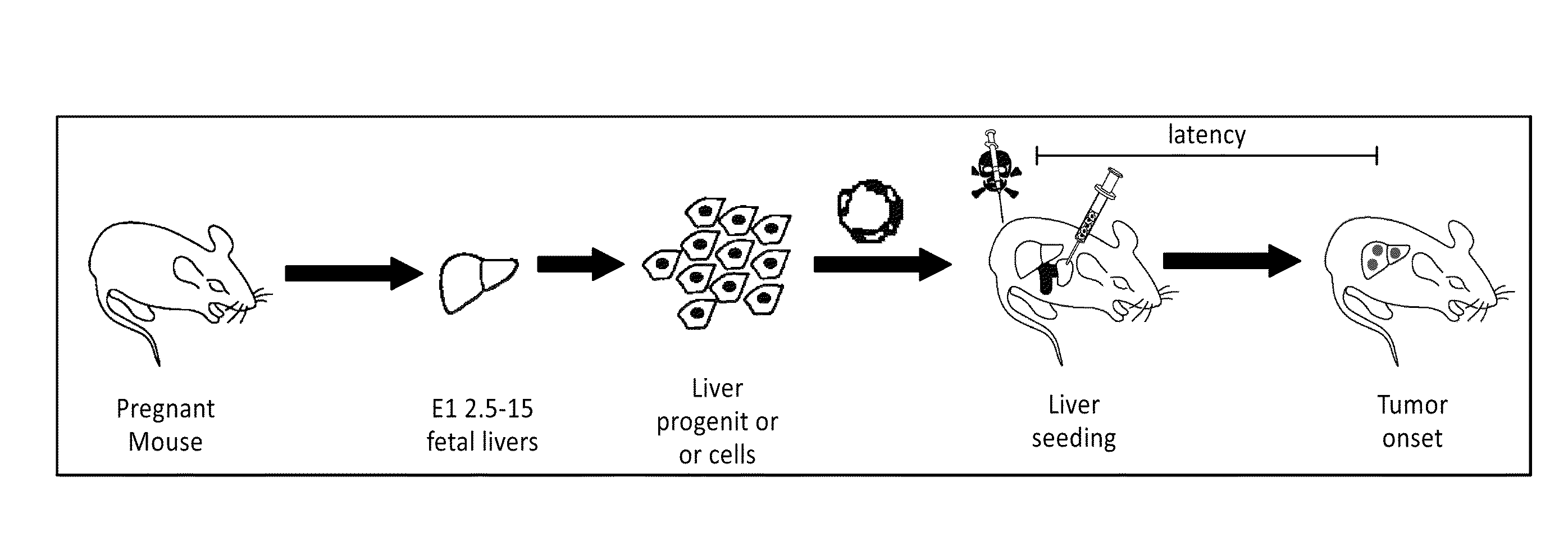ONCOGENOMICS-BASED RNAi SCREEN AND USE THEREOF TO IDENTIFY NOVEL TUMOR SUPPRESSORS
a tumor suppressor and oncogenomics technology, applied in the field of genetically tractable in situ nonhuman animal models of liver cancer, can solve the problems of ineffective systemic chemotherapeutic treatment, difficult to cure these tumors, and no single drug or drug combination prolongs survival, so as to achieve a slow increase in cell number
- Summary
- Abstract
- Description
- Claims
- Application Information
AI Technical Summary
Benefits of technology
Problems solved by technology
Method used
Image
Examples
example 1
Generation and Transplantation of Genetically Altered Liver Progenitor Cells
[0247]To determine whether genetically modified hepatoblasts could colonize recipient livers, a protocol was used that optimizes engraftment of transplanted cells in the recipient liver. Embryonic hepatoblasts express high E-Cadherin levels on their cell surface, which enables these cells to be isolated to high purity from fetal livers using magnetic bead selection. (Nitou et al. “Purification of fetal mouse hepatoblasts by magnetic beads coated with monoclonal anti-e-cadherin antibodies and their in vitro culture.”Exp. Cell Res. 279, 330-343. (2002)). These cells express markers characteristic of bi-potential oval cells, the presumed cellular target of transformation in the adult rodent liver.
[0248]Animals were pretreated with retrorsine, an alkaloid that exerts a strong and persistent block of native hepatocyte proliferation and increases the competitive advantage of transplanted cells. Ten days after the ...
example 2
[0265]An integrated oncogenomic approach was undertaken to identify new tumor suppressor genes in hepatocellular carcinoma. MicroRNA based shRNA technology was combined with a progenitor cell derived mouse model of liver cancer to perform in vivo RNA interference screens for new tumor suppressor genes in liver cancer.
Selecting RNAi Libraries Based on Human Oncogenomic Data
[0266]98 human hepatocellular carcinomas of different etiologies were analyzed by Representational Oligonucleotide Microarray (ROMA) analysis, a high resolution array-CGH based platform, in order to identify recurrent focal genomic deletions. 59 focal genomic deletions (a). To allow for in vivo RNAi screening, SalI / MluI fragments (which contains shRNAmir and a unique barcode sequence for every hairpin sequence) were shuttled from the low complexity pSM2c library pools (FIG. 14b) into an MSCV based retroviral vector which has been optimized for in vivo use (FIG. 14c). In this vector the microRNA based shRNAs are dri...
example 3
Representational Oligonucleotide Microarray Analysis (ROMA)
[0294]Human tumor samples were obtained. The ROMA array-CGH method enables genome-wide profiling of DNA copy number at high resolution (Lucito et al., 2003, Genome Res. 13: 2291-2305). This method was utilized to study gene-dosage alterations in human HCC. A total of 86 HCC samples from three different sources, together with 12 liver cancer cell lines, were analyzed. Microarray measurements were converted to copy number estimates using a segmentation algorithm based on Kolmogorov-Smirnov statistics. In order to restrict subsequent analysis to cancer-associated somatic genetic events, an automated procedure was utilized to mask common germline copy number variations (Lucito et al., 2003). Next, an automated method similar to the MCR method developed by Tonon et al. (2005, Proc. Natl. Acad. Sci. U.S.A. 102: 9625-9630) was utilized to catalog homozygous and other focal deletions (segmented DNA copy number<=0.75 and size<=20 Mb)...
PUM
| Property | Measurement | Unit |
|---|---|---|
| concentrations | aaaaa | aaaaa |
| concentrations | aaaaa | aaaaa |
| concentrations | aaaaa | aaaaa |
Abstract
Description
Claims
Application Information
 Login to View More
Login to View More - R&D
- Intellectual Property
- Life Sciences
- Materials
- Tech Scout
- Unparalleled Data Quality
- Higher Quality Content
- 60% Fewer Hallucinations
Browse by: Latest US Patents, China's latest patents, Technical Efficacy Thesaurus, Application Domain, Technology Topic, Popular Technical Reports.
© 2025 PatSnap. All rights reserved.Legal|Privacy policy|Modern Slavery Act Transparency Statement|Sitemap|About US| Contact US: help@patsnap.com



